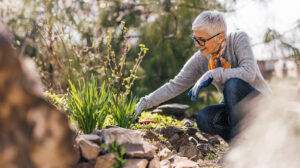‘Are you ready to get down and dirty? I know I am!’
By Deborah Dittner
 This is the time of year when you complete your gardening plans and prepare for the actual planting. I’m certainly ready. How about you? The warmer weather and staying lighter later into the day encourage you to start producing your gardening dreams for the upcoming season.
This is the time of year when you complete your gardening plans and prepare for the actual planting. I’m certainly ready. How about you? The warmer weather and staying lighter later into the day encourage you to start producing your gardening dreams for the upcoming season.
As food prices continue to rise, planting a garden of any size will definitely help your nutritional needs and save you financially. There is also the possibility of community gardens if space is an issue. For a small fee, you can get a decent-sized space to grow your vegetables and herbs.
Growing vegetables and herbs is fun, gets you outdoors in fresh air, soaking up the sun (YAY vitamin D!!) and moving your body (exercise needed). The size of the area you have to plant will determine how much you’ll be able to grow.
For those of you living in an apartment, space can be a concern. Windowsills can usually handle some basic herbs such as mint or rosemary. You may need to grow in containers outside your front door as this will still produce a bounty of veggies and herbs. Using containers of all shapes and sizes and colors will house herbs and a variety of veggies from lettuce to tomatoes to squash to potatoes and so much more. Planting in a container decreases the need to weed, keeps animals from noshing on veggies as a snack and allows you to keep a better eye on the soil conditions so you know when watering is needed which can be more frequently in a pot.
Placing large rocks (also can be decorative) on top of the soil will allow for even watering and with additional watering comes additional fertilizing.
If you find that a plant needs more sun or less sun, they can easily be moved to the other side of the area allowing it to thrive. Containers come in a variety of shapes and sizes and you get to choose the look you are looking for that will not only produce great veggies and herbs but is also pleasing to the eye. Make sure there are sufficient drainage holes to prevent root rot. By placing some dry tree twigs at the bottom quarter of the container before adding the soil will help to absorb and retain the water. Adding pots on the stairs into your space is another great place for growth and décor. Depending on the plant, you can also bring them indoors come colder months. Hanging planters for edible flowers is also appealing to the eye.
What to plant in containers? These are few of my favorites:
Herbs
• Basil (do I hear pesto anyone?)
• Cilantro
• Lemon balm (my favorite tea)
• Parsley
• Rosemary
• Sage
• Thyme
Vegetables
• Arugula
• Spinach
• Lettuce — many varieties to choose
• Peppers (all varieties)
• Potatoes (grown in a potato bag produces greenery but most importantly beautiful potatoes)
• Tomatoes
The type of soil should be light with a slow-release fertilizer. Consult with the gardening supply store as to the best soil necessary for growing container herbs, flowers and vegetables in your area. Remember to fertilize as recommended for the plant to grow lush and tasty veggies and herbs.
Your plants will need direct sunlight of eight hours daily. Depending on your location, moving the containers may be needed to obtain the necessary lighting. Consider the lighting to help determine the type of plants you will be able to grow.
Watering, both overwatering and underwatering, can be detrimental to the plant. Seedlings need continuously moist soil. Drainage or the use of self-watering vessels are important to the plant’s success. If possible and space permitting, consider a rain barrel to capture rainwater which can save you trips to the faucet.
For those of you with more space — that is wonderful!
Build raised beds or raised rows with wood, logs or stone. These should be no wider than three to four feet (you want to be able to get to the center with ease) and as long as you like or space allows. Depending on your location and the type of soil will depend on what to add to your beds. A trip to the local garden center will provide you with answers and the tools you need.
With more space you can add variety and more plants. Some of my favorite garden plants are:
• Tomatoes
• Eggplant
• Arugula
• Cabbage (yum sauerkraut!)
• Sugar snap peas
• Zucchini
• Pumpkin
• Asparagus
• Potatoes
• Green beans
• Rhubarb (perennial)
• Fruit trees (apple, pear)
• Peppers
• Lettuce — varieties
• Variety of herbs (basil, thyme, sage, lemon balm)
Do you have a gardening friend?
If so, consider each of you to grow different vegetables and share your harvest. This way more items can be grown and you’ll learn from each other about technique.
Don’t forget to keep a garden journal. This way you can be certain of the type of seeds and plants you used, the soil and fertilizer used, location of plants, the weather (especially last frost and if it was rainy season) and more.
I always enjoy planning and plotting my garden on paper in early spring. This way you make sure what plants to purchase and/or when to start the seedlings indoors. Create a “symbol key” such as T for tomatoes, Z for zucchini, P for peppers, etc. as you plot locations. A sketch of your garden will help in future planning especially with crop rotation. Initially you may want to jot down information daily as the spring garden is fast growing. Once established you may want to jot your notes weekly or bi-weekly. Pest information such as potato bugs or tomato worms. Do not forget harvest information such as yield from certain plants if using a variety. If you have questions, write them here as well. Take your journal when visiting a fellow gardener or trip to the garden shop. And always take pictures. It is so much fun looking at gardens and the harvest of the past.
 Deborah Dittner is a family nurse practitioner and health consultant. Her mission is to transform as many individuals as possible through nutrition and lifestyle changes. www.debdittner.com
Deborah Dittner is a family nurse practitioner and health consultant. Her mission is to transform as many individuals as possible through nutrition and lifestyle changes. www.debdittner.com

